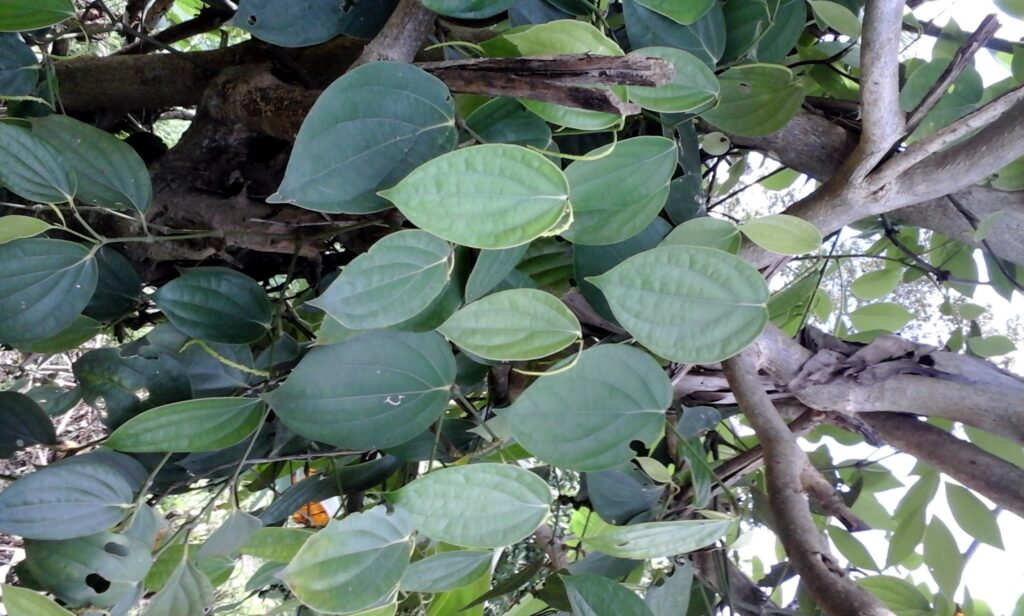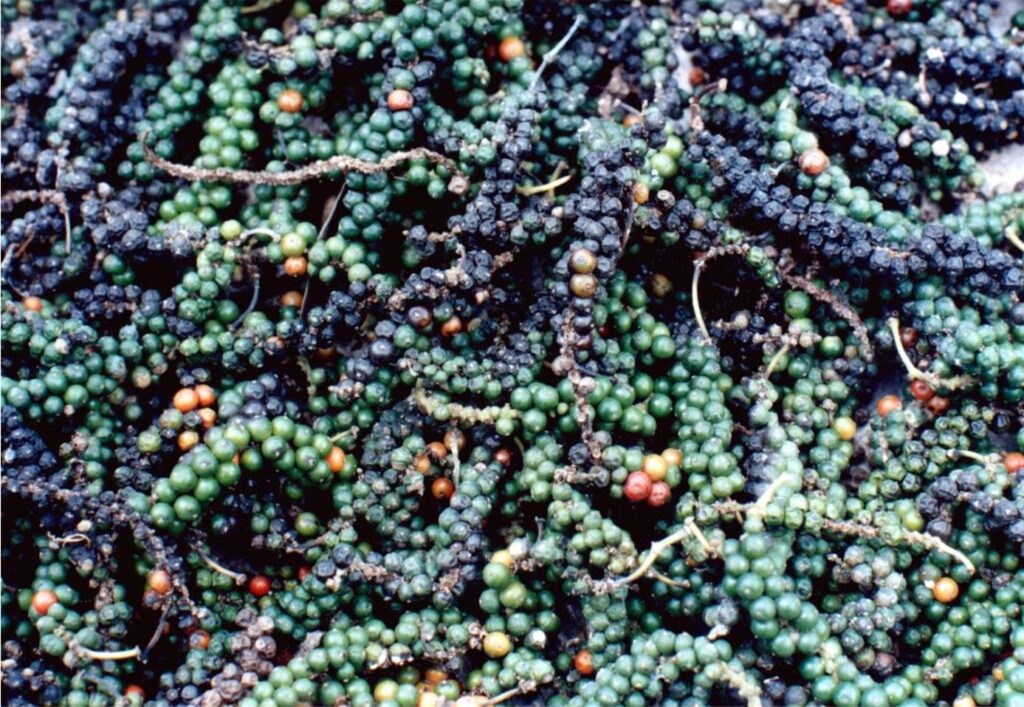Text and Photos by Henrylito D. Tacio
Black pepper (” Piper nigrum” Linn), known locally as “paminta,” is one of those neglected crops grown in the Philippines. It is used extensively by food manufacturers as a seasoning agent in the preparation of both exquisite and everyday dishes. As a spice, it makes food taste better. It is essential in local dishes like “kilawin,” “lauya,” “mami,” “pansit,” “adobo,” “mechado,” and many other preparations.
Unknown to many Filipino farmers, black pepper — being a tropical plant — can be grown profitably in many areas of the country where the soil is well-drained and fertile.
It grows better under partial shade than in an open field, a characteristic that makes the plant good for backyard farming. It can also be grown between coffee and cacao trees. Most black pepper farms are found in Batangas, Laguna, Quezon, Negros Occidental, Zamboanga and Davao.
“There are four varieties of black pepper,” says the Davao-based Mindanao Baptist Rural Life Center (MBRLC) Foundation, Inc., referring to large-leafed, small-leafed, tall, and short. “You can plant any of these varieties in your farm or backyard.”
According to the MBRLC, black pepper is a creeping plant. “The plant needs posts to climb on,” the center states. Commonly used support trees – which are planted ahead of time – include “ipil-ipil,” “madre de cacao,” and “dapdap.” The supports must be at least three to four meters high, 2.5 meters between rows.
Here are more tips on growing black pepper:
Black pepper can be propagated with cutting or with seeds. The latter is not recommended for commercial purposes. But either way, it’s necessary to have a propagation bed where the cuttings can be rooted or the seeds germinated and nursed to transplanting age. The seedling bed should be of fine, rich soil and should be located in a shaded area. It should be kept constantly moist – not too wet and not too dry – at all times until the plants are ready for transplanting.
For seed propagation, only the berries that are orange or red in color are harvested. The berries should be picked only from vigorous, disease-free plants of the desired variety. It is a common practice to place the seeds in a cloth bag and soak this in water for two to three days before sowing. The seeds are sown in the bed six inches apart in rows and covered with fine soil about two inches thick.
The seedlings are ready for transplanting when they are about one year old. In transplanting, it is advisable to retain as much of the soil clinging to the roots as possible. A reminder: Plants raised from seeds grow more slowly and require more care than plants grown from cuttings.
Cuttings for propagation should be taken from vigorous, heavy-yielding plants which are below the node and 20 inches or more in length with plenty of roots at their joints. “Remove side branches,” MBRLC advises, “because they don’t climb but sprawl.”
The cuttings are inserted into the soil of the bed in a slanting position with half their length buried. Cuttings are ready for transplanting when they show vigorous growth and are fully rooted. In transplanting, the seedlings should be “balled” or provided with plenty of soil clinging to their roots.
Black pepper can also be propagated by means of marcotting. Here are the steps: From the tip of a black pepper branch, look for the node with whitish aerial roots that is less than a centimeter long. Enclose the node in a container. Tie it securely to the support. A tin can, waxed paper cup, or plastic bag can be used as a container.
The container is filled with fine, dry humus or sandy loam soil. “Pour in a little at a time until it reaches the length of the internode just above the node to be marcotted,” MBRLC recommends. The marcot is watered lightly. The soil should not be pressed against the delicate roots.
After a month, the young marcot is cut from the mother plant. The stem is very close to the container using sharp pruning shears or a knife. The newly-cut marcot is placed in a bigger container such as a clay pot or a plastic bag. The delicate roots should not be disturbed. Then, the marcot is hardened by placing it in a partial shade for three to four months. Watering it excessively is not recommended.

Black pepper plant 
Black pepper being dried
The rooted seedlings are transplanted at the start of the rainy season. Two or three seedlings are planted a few centimeters away from the base of each support tree. Before placing the plants in the prepared holes, the plastic bags are removed carefully so that the plants and soil are still holding together.
Black pepper should not be allowed to grow tall. As the vines climb the supports, the tops should be pulled down as they reach the desired height of two to three meters. Every three months, manure or compost is applied to each hill to maintain plant growth. In addition, pests and diseases attacking the plants must be controlled. Weeding must be employed, too.
Black pepper starts to bear fruit as early as the first year after planting. The fruits are green at first, turning yellow and then red and then black when they mature. Generally, the first harvest of blackberries – which varies from one-half to one kilogram per plant – is in its third year. Full production comes in the sixth or seventh year (the yield is approximately 1.5 kilograms per plant), and the plant produces continuously for 15 or more years.
The fruits on a bunch do not all mature at the same time. In backyard growing, only the matured ones are harvested, and the green immature berries are left to be harvested later on. In commercial plantations, however, to facilitate harvesting, the operation should be delayed until almost all fruits on a bunch are matured. Then the whole bunch could be gathered in a simple operation instead of picking the individual fruits one by one as they mature.
After harvesting, dry the berries immediately under the sunlight until they become black and wrinkled. The ideal remaining moisture content of black pepper is 12 percent. Properly dried berries can be stored for long periods of time.
Unknowingly, black pepper is sold in the market in two forms -black and white. If the latter is desired, the best and ripest berries are selected and submerged in water for one to two weeks to let them soften. After soaking, the berries are allowed to ferment before the outer hull is removed. After doing so, the berries are being ground, and presto — you have the white pepper!

